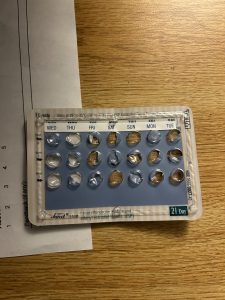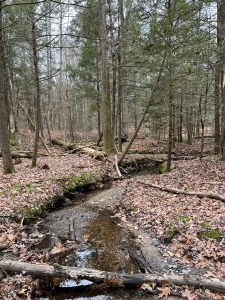Something that I routinely throw away is the Q-tips, I use them often when I do my makeup and I have been doing a lot of henna lately and it is convenient to clean up my work with Q-tips. I think that if these were found in the future, they would not be able to be fully distinguished. I think that they could draw out that the culture of my time was wasteful and artistic. I also think that they would assume that the main priority of the time was convenience.
I Hope its Not Just a Pack of Pills
Every three weeks I throw an empty pack of birth control pills in the trash. From this an archaeologist would probably assume a few things right away: that I am sexual active and probably straight. Neither of these things are true but because they are the main purposes of this refuse, they are easy assumptions to make. The fact that these pills only have three weeks instead of four might drive them into more accurate information. It would be interesting to see if there have been any strides made in afab reproductive health, to see if maybe upon further inspection they would know exactly why I take them and think how primitive our science is and there is something 1000 that is much more affective than disrupting natural bodily function. In that case they would be able to tell that in this post roe era there is very little being done to protect women and afab bodies. I hope they would think it is foolish how we treat half a species as disposable. Even if I don’t use birth control for its intended purpose, I think they would know that as afab bodies it is easier to guess because the actual diagnosis process is extremely invasive because no one is doing the research to find an easier and less invasive way of doing it. I hope they know that I throw the pack away while there is a sign outside my dorm telling people not to let doctors gaslight them into thinking there isn’t a problem. I hope that when they see three empty line of pills that there was a problem and I hope they have fixed it by then.

Archaeology
Aside from napkins, something I throw out in the trash a good amount of times are receipts. It’s a wasteful habit of mine because although there are email or paper options, I always like to have paper receipts just in case( although nothing happens). Archaeologists might assume that I like to go out occasionally, and explore the areas I’m in. An incorrect assumption is probably that I’m a shopaholic, and can’t live without buying things. I’d say this is incorrect since the things I buy have a variety, usually food, clothes, or gifts.
Yarn Re-spun
I use a lot of yarn and other fibers. It would be really interesting to see the acrylic yarn I use turned into new yarn or stuffing for other projects I work on. It wouldn’t take much to make this work because yarn can be broken down and turned into new fiber pretty easily. It would require fiber artists to send their scraps back to yarn companies which would require all the colors to be mixed up. Though they would need to be separated by type because specialty yarns probably couldn’t be recycled in the same manor. With normal acrylic fiber it would just take the separation of those fibers, possibly the bleaching and dying, the washing, and then re–spinning to turn them into new yarn.
A walk in the woods
When you are walking through the woods and then all of a sudden you see a soda bottle or a beer can. This disrupts the idea that the woods or nature are somehow a place untouched by man, which can be a very violent idea when you realize the separation that provides. Humans thinking that we are separate from nature allows us to see ourselves as above it, a governing force that can choose to protect or destroy but that is false. People are just as much a part of nature as ever bug and fern no matter how hard we try to distance ourselves. When we see a piece of trash in a seemingly natural space it forces us to confront this idea. This idea of separation isn’t only a human idea it is a colonial one. Native and indigenous people all over the Earth have known that we are all as much a part of nature as everything else. Nature is not above us and we are not above nature. This idea of utopian forests that are untouched by people allows us to ignore the fact that people and nature are equals who have been interacting for thousands of years.
The Woods as a Form of Waste Separation
The woods on campus are not something most people would think of when they think of waste, but when thinking about what the trail is called, a “nature trail”, you start to realize that it’s related to waste separation more than you might have originally thought. Nature trails are meant to be a way of allowing people to separate themselves from technology, buildings, and generally any visible human influences on the world. This can be thought of as a form of waste separation, although instead of removing the waste from the view of people, the people are being removed from the waste. In this case, the waste is not really being taken care of, since this form of waste separation is just ignoring the issues at hand in favor of looking at the parts of the world that do not look like they are fully affected. This, unfortunately, leads to waste being added to these areas since people will throw empty bottles and food wrappers on the ground deciding that it does not matter since they will never see it again.

Archaeology
In class we discussed how an everyday object and parts of our lives that will be seen in the far future and how people in the future will see our lives today. The object I will be selecting is a plastic bottle from the Poland spring company. This Product is held together by glue and plastic. Today we would see products like this as single use, but in the future they will see it as something that can last for a very long time. Though how they take it will be a mystery to us we can only assume they will take it the worst way as these products will be found in mass quantities. As our greatest success also may become our downfall and only remnants.
Archaeology
One thing I routinely throw in the trash is gum. The marketing of gum is a really interesting thing to examine, in that it is strongly linked to candy marketing targeting children and teens. Nowadays, it seems that there is every possible flavor of candy and gum. This is something that I feel has been on the rise in the past two decades or so. For example, I remember as a kid in a grocery store checkout line just seeing Reese’s Peanut Butter Cups, as the token Reese’s product. Now, when I look through grocery store checkout lines, I see about six different Reese’s products. Therefore, I imagine when archaeologists dig up all the candies and gums, a view of marketing and the larger number of products would be clear. With the strong rise of technology, advertising has certainly changed, leaving old tactics to possibly be not as effective, so insight into that could be discovered by archaeologists as well. At times, chewing gum has been seen as a sign of disrespect, for example my childhood classrooms, as it was not something we were allowed to have. However, I am not sure how common this idea is now. Therefore, looking at the frequency of people’s gum consumption and where it happens intrigues me. Overall, seeing where gum is found most often would give archaeologists an understanding of our world’s levels of acceptability or not of gum, who is consuming it and why, and how marketing and advertising have influenced these things, specifically in children’s lives.
Circular Economy
In class we discussed how a circular economy would work. We read multiple articles on how it would work, then we discussed what we thought of the paper and the probability of this working. One of the concerns in the article were the advancement or lack of advancement due to the reuse of the same materials over and over again. With the invention of new materials and products how will we keep reusing the old ones. The writer shows that there is no clear solution to this. In class we also brought up politicians disregard for this idea and how they make decisions for this without the necessary research to see what the impact of it will be towards this topic.
Archaeology – prompt
Choose an object you routinely throw in the trash. (Include a photo if possible.) Imagine an archaeologist excavating this object 1000 years in the future. What conclusions do you think they will be able to draw about you or your culture based on this object, where it was placed, and the other things they will likely find around it? What are some possible incorrect assumptions they may have about you or your culture based on these material remains?
Readings from this week:
Shanks, Michael, David Platt, and William L. Rathje. “The Perfume of Garbage: Modernity and the Archaeological.” Modernism/Modernity 11, no. 1 (2004): 61–83. https://doi.org/10.1353/mod.2004.0027.
Edensor, Tim. “Waste Matter – The Debris of Industrial Ruins and the Disordering of the Material World.” Journal of Material Culture 10, no. 3 (November 2005): 311–32. https://doi.org/10.1177/1359183505057346.